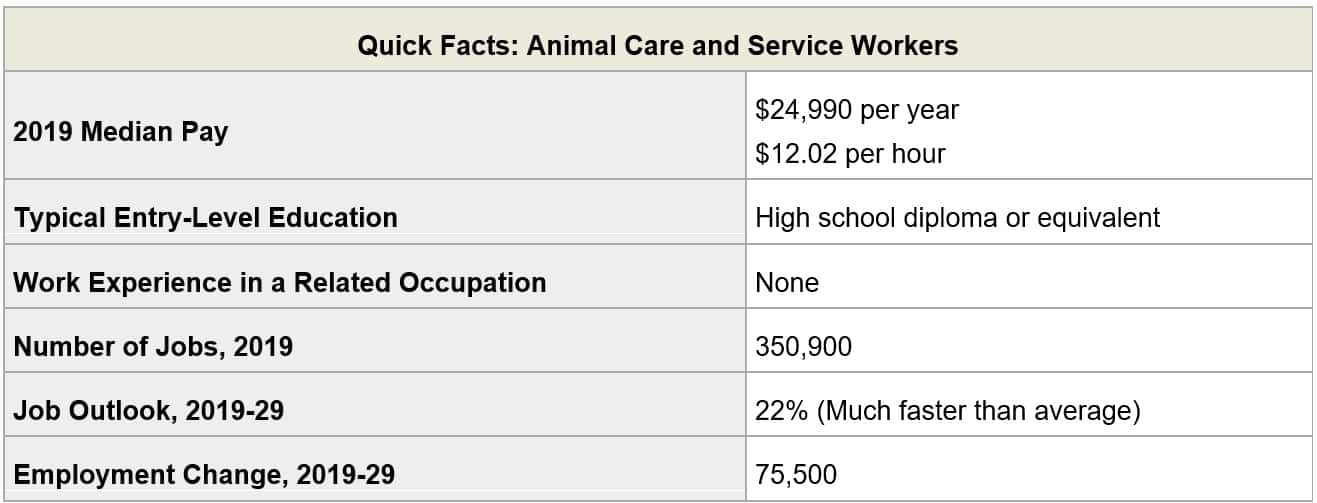Learn about the Pet Care Services Business and find information on how to open your own Pet Care Services Business. Don’t forget you can receive free or low-cost training and free professional business advice, from your local Small Business Development Center!
View our related business reports here: Pet Supply Store Business
Get a free Pet Care Services Business plan template on our Business Plans page.
Pet Care Services Business COVID-19 Resources
The global COVID-19 pandemic, shelter-in-place orders and physical distancing measures have affected many businesses. Here is a look at the impact to the Pet Care Services industry.
Due to the large amount of people who were either laid off or placed under stay at home orders, demand for pet sitting and boarding has declined as people are able to spend more time taking care of their pets. Additionally, many people have been forced to decrease their spending on discretionary services. It’s not all bad news, however, as recent trends analysis suggests pet ownership will remain stable or even rise during the COVID-19 economic downturn.
- SBDCNet COVID-19 Small Business Resources
- CDC – Pets and Other Animals
- IBPSA COVID-19 Resources
- APPA COVID-19 Resources
- AVMA COVID Resources
Pet Care Services Industry Overview & Trends
NAICS Code: 812910, SIC Code: 0752
In 2019, pet owners spent $95.7 billion on their pets according to the American Pets Product Association and that number is expected to increase to $99.0 billion in 2020. Other Services such as boarding, grooming, training, pet sitting and all other services except veterinary care account for $10.3 billion in the industry’s revenue. Spending on pet care services has vastly increased over the past decade, according to United States Census Bureau.
This Pet Care Services industry summary is from First Research which also sells a full version of this report.
- “Companies in this industry provide grooming, specialized training, and boarding services for companion animals. Major US companies include PetSmart, PETCO Animal Supplies, and Best Friends Pet Care. The US and the UK have typically been leading pet-owning countries. Other major international markets for pet grooming and boarding include the BRIC nations: Brazil, Russia, India, and China. In particular, China and India are experiencing an increase in pet ownership rates as economies develop and people’s attachment to pets drives spending.
- The US pet care services industry includes about 17,000 establishments (single-location companies and units of multi-location companies) with combined annual revenue of about $5 billion. The industry includes animal shelters. Services provided by veterinarians and pet supplies retailers, which are not included in the industry, are covered in the Veterinary Services and Pet & Pet Supplies Stores profiles, respectively.
- Competitive Landscape: Demand is driven mainly by the number of cats and dogs kept as pets, which is affected by demographics and economic conditions. The profitability of an individual pet care company depends on marketing skills, reputation, and the range of services offered. Large companies enjoy economies of scale in marketing as well as better access to capital to invest in boarding and grooming equipment and in training programs. Small practices can compete effectively by specializing in particular animals or types of grooming or training, or by serving an exclusive area.”
These Pet Care Services business market insights are derived from is from Euromonitor, which also sells a full version of this report.
- Increasing Humanization: Americans are increasingly willing to spend more on their companion animals and treat their pets as family members. This rising in social status has been accompanied with increased spending on pet care services such as grooming, treats, and lessons
- Rising Pet Ownership: The number of Americans owning pets continues its upward trend, translating into a substantial increase in the industry sector’s revenues. The number of pets in the USA increased by 2% over the year, with more than 32% of households owning a cat and nearly 37% owning a dog. Household spending on industry services was also facilitated by good economic development, rising employment, and increasing salaries.
- The pet population is also projected to continue growing. According to a survey by the American Pet Products Association (APPA) pet ownership saw most significant growth in 2-person households, and among millennials and generation-Y consumers. With many young people delaying having children, the number of cats and dogs will continue to increase, with many people preferring smaller dog breeds rather than large dogs
The AVMA provides a table with data on relevant pet statistics here. Additionally, the AVMA provides a Pet Market Share Estimator for estimating the number of pets in a community using the human population of the area and the estimated rate of pet ownership.
Pet Care Customer Demographics
Major customer segments for pet grooming and boarding are reported by IBISWorld. The full version of the report is available for purchase here.
- IBISWorld estimates 2020 Industry revenue to be approximately $9.2 billion, with market segmentation determined by pet owner age groups.
- Pet owners between the ages 18 and 29 are approximately 15.6% of revenue. Although they own pets at a very high rate, they often lack the money to afford discretionary purchases such as pet training or grooming and may opt to perform these services on their own rather than pay someone to do it for them.
- Pet owners between the ages 30 and 49 are the largest industry segment at 40%. This age group tend to find themselves busy with work, traveling, and family obligations, all which lead to needing industry services. Furthermore, this age segment has the highest percentage of pet ownership of all age groups.
- Pet owners between the ages 50 and 64 comprise 33.5% of industry revenue. People in this age group often have pets for companionship and are financially stable, allowing them to spend high dollar amounts on pet services
- Pet Owners 65 and older are the smallest industry segment at 10.9%. Due to the large amount of effort required in having a pet, people in this age group own pets at the lowest rate. However, those senior citizens that do own pets often spend high amounts on services for them.
Find further information on pet care services customers in a variety of topical and trade publications, including:
- Trends in Pet Care Mirror Those of Pet Owners | Nielsen Insights
- Pet Care Industry Analysis 2020 – Cost & Trends
- 2019-2020 APPA Pet Owners Survey (available for purchase)
Pet Services Business Startup Costs
Startup costs for pet care services vary greatly depending on the multiple different types of services offered. Links to various pet care services startup costs are below:
- Dog Grooming Business Startup Costs from Entrepreneur Magazine: “Total Startup costs: Under $2,000″
- Dog Day Care Business Startup Costs from Entrepreneur Magazine: “Total Startup costs: $2,000 – $10,000″
- Mobile Pet Grooming Business Startup Costs from Entrepreneur Magazine: “Total Startup costs: $10,000 – $50,000″
- Dog Day Care Business Startup Costs breakdown from Paws Dog Day Care: Total startup costs range from $24,350 to $143,300, with average total startup costs around $81,700
Find additional pet care services startup costs information through the following links:
- What Is the Cost to Start a Dog Daycare Business? – Chron
- Pet Sitting Business Startup Costs
- List of Dog Walking Startup Costs – Chron
- Animal Businesses With Low Start-up Costs
Pet Services Business Plans
- Dog and Cat Kennel Business Plan
- Dog Obedience School Business Plan
- Animal Day Care Business Plan
- Pet Sitter Business Plan
- Pet Sitting Business Plan
- Dog Groomer and Kennel Business Plan
Pet Care Business Associations
Trade associations often are excellent sources of information on an industry. Here are some relevant industry associations:
- National Cat Groomers Institute
- National Dog Groomers Association of America, INC.
- American Pet Products Association
- American Veterinary Medical Association
- International Boarding & Pet Services Association
- National Association of Professional Pet Sitters
- American Humane
- American Kennel Club
Pet-Related Business Regulations
The section is created to provide a general awareness of regulations and agencies to consider when starting a Pet Care Services Business. Check with your state and municipality for rules and regulations that may impact the business in your area. Most regulations are set at the local level and likely address information such as a maximum number of animals allowed, pet waste cleanup, and zoning concerns.
Pet Care Business Publications
Animal Care Business Employment Trends
The US Census Bureau reports on the size of the pet care services workforce:
- “With over 100,000 pet care service businesses, this industry increased its number of establishments by more than 60% since 2007
- The number of people employed in pet care services rose sharply from 2007 to 2017. Excluding the self-employed, the number of workers grew from 52,855 paid employees to 111,384, a 111% increase”
Here is the Animal Care and Service Workers labor market summary from the Bureau of Labor Statistics.

- “Pay: The median annual wage for animal caretakers was $24,780 in May 2019. The median wage is the wage at which half the workers in an occupation earned more than that amount and half earned less. The lowest 10 percent earned less than $18,630, and the highest 10 percent earned more than $38,630. The median annual wage for animal trainers was $30,430 in May 2019. The lowest 10 percent earned less than $20,810, and the highest 10 percent earned more than $59,110.”
- “Work Environment: Animal caretakers held about 300,700 jobs in 2019… Animal trainers held about 50,200 jobs in 2019… Animal care and service workers are employed in a variety of settings. Many work at kennels; others work at zoos, stables, animal shelters, pet stores, veterinary clinics, and aquariums. Their work may involve travel. Although animal care and service workers may consider their work enjoyable and rewarding, they face unpleasant and emotionally distressing situations at times. For example, those who work in shelters may observe abused, injured, or sick animals. Some caretakers may have to help veterinarians euthanize injured or unwanted animals. In addition, a lot the work involves physical tasks, such as moving and cleaning cages, lifting bags of food, and exercising animals.”
- “Job Outlook: Overall employment of animal care and service workers is projected to grow 22 percent from 2019 to 2029, much faster than the average for all occupations. Many people consider their pets to be a part of their family and are willing to pay more for pet care than pet owners have in the past. As more households include companion pets, employment of animal care and service workers in the pet services industry will continue to grow. Employment of animal care and service workers in kennels, grooming shops, and pet stores is projected to increase in order to keep up with the growing demand for animal care.”
A more specific breakdown of wages for other animal care businesses in the US can be found here (see 39-2000, 392011, and 392021).
Additional Resources
Already in business or thinking about starting your own small business? Check out our various small business resources:
- View more business reports here: Small Business Snapshots
- View small business help topics here: Small Business Information Center
- View industry-specific research here: Market Research Links
- View business plans samples here: Sample Business Plans
Remember, you can also receive free professional business advice and free or low-cost business training from your local Small Business Development Center!
Photo by Jamie Street on Unsplash.






